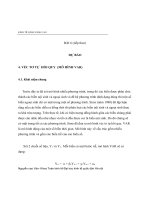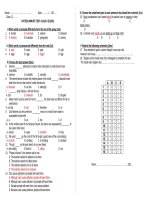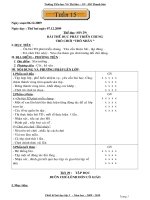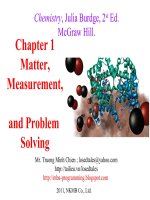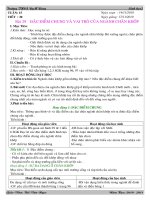Bài giảng Chapter 15 Acids and Bases
Bạn đang xem bản rút gọn của tài liệu. Xem và tải ngay bản đầy đủ của tài liệu tại đây (3.37 MB, 136 trang )
Chapter 15
Acids and
Bases
2011, NKMB Co., Ltd.
Chemistry, Julia Burdge, 2
st
Ed.
McGraw Hill.
Mr. Truong Minh Chien ;
/>
2
Stomach Acid & Heartburn
•
the cells that line your stomach produce hydrochloric
acid
to kill unwanted bacteria
to help break down food
to activate enzymes that break down food
•
if the stomach acid backs up into your esophagus, it
irritates those tissues, resulting in heartburn
acid reflux
GERD = gastroesophageal reflux disease = chronic leaking
of stomach acid into the esophagus
Chemistry, Julia Burdge, 2
nd
e., McGraw Hill.
3
Curing Heartburn
•
mild cases of heartburn can be cured by
neutralizing the acid in the esophagus
swallowing saliva which contains bicarbonate ion
taking antacids that contain hydroxide ions and/or
carbonate ions
Chemistry, Julia Burdge, 2
nd
e., McGraw Hill.
5
Common Acids
Chemical Name Formula Uses Strength
Nitric Acid HNO
3
explosive, fertilizer, dye, glue
Strong
Sulfuric Acid H
2
SO
4
explosive, fertilizer, dye, glue,
batteries
Strong
Hydrochloric Acid HCl
metal cleaning, food prep, ore
refining, stomach acid
Strong
Phosphoric Acid H
3
PO
4
fertilizer, plastics & rubber,
food preservation
Moderate
Acetic Acid HC
2
H
3
O
2
plastics & rubber, food
preservation, Vinegar
Weak
Hydrofluoric Acid HF
metal cleaning, glass etching
Weak
Carbonic Acid H
2
CO
3
soda water
Weak
Boric Acid H
3
BO
3
eye wash
Weak
Chemistry, Julia Burdge, 2
nd
e., McGraw Hill.
Tro, Chemistry: A Molecular Approach 7
Structure of Acids
•
oxy acids have acid hydrogens attached to
an oxygen atom
H
2
SO
4
, HNO
3
Tro, Chemistry: A Molecular Approach 8
Structure of Acids
•
carboxylic acids have
COOH group
HC
2
H
3
O
2
, H
3
C
6
H
5
O
7
•
only the first H in the
formula is acidic
the H is on the COOH
Tro, Chemistry: A Molecular Approach 9
Properties of Bases
•
also known as alkalis
•
taste bitter
alkaloids = plant product that is alkaline
often poisonous
•
solutions feel slippery
•
change color of vegetable dyes
different color than acid
red litmus turns blue
•
react with acids to form ionic salts
neutralization
Tro, Chemistry: A Molecular Approach 10
Common Bases
Chemical
Name
Formula
Common
Name
Uses Strength
sodium
hydroxide
NaOH
lye,
caustic soda
soap, plastic,
petrol refining
Strong
potassium
hydroxide
KOH caustic potash
soap, cotton,
electroplating
Strong
calcium
hydroxide
Ca(OH)
2
slaked lime cement Strong
sodium
bicarbonate
NaHCO
3
baking soda cooking, antacid Weak
magnesium
hydroxide
Mg(OH)
2
milk of
magnesia
antacid Weak
ammonium
hydroxide
NH
4
OH,
{NH
3
(aq)}
ammonia
water
detergent,
fertilizer,
explosives, fibers
Weak
Tro, Chemistry: A Molecular Approach 13
Arrhenius Theory
•
bases dissociate in water to produce OH
-
ions and
cations
ionic substances dissociate in water
NaOH(aq) → Na
+
(aq) + OH
–
(aq)
•
acids ionize in water to produce H
+
ions and anions
because molecular acids are not made of ions, they cannot
dissociate
they must be pulled apart, or ionized, by the water
HCl(aq) → H
+
(aq) + Cl
–
(aq)
in formula, ionizable H written in front
HC
2
H
3
O
2
(aq) → H
+
(aq) + C
2
H
3
O
2
–
(aq)
Tro, Chemistry: A Molecular Approach 14
Arrhenius Theory
HCl ionizes in water,
producing H
+
and Cl
–
ions
NaOH dissociates in water,
producing Na
+
and OH
–
ions
Tro, Chemistry: A Molecular Approach 15
Hydronium Ion
•
the H
+
ions produced by the acid are so reactive they
cannot exist in water
H
+
ions are protons!!
•
instead, they react with a water molecule(s) to produce
complex ions, mainly hydronium ion, H
3
O
+
H
+
+ H
2
O → H
3
O
+
there are also minor amounts of H
+
with multiple water
molecules, H(H
2
O)
n
+
Tro, Chemistry: A Molecular Approach 16
Arrhenius Acid-Base Reactions
•
the H
+
from the acid combines with the OH
-
from the base to make a molecule of H
2
O
it is often helpful to think of H
2
O as H-OH
•
the cation from the base combines with the
anion from the acid to make a salt
acid + base → salt + water
HCl(aq) + NaOH(aq) → NaCl(aq) + H
2
O(l)
Tro, Chemistry: A Molecular Approach 17
Problems with Arrhenius Theory
•
does not explain why molecular substances, like NH
3
,
dissolve in water to form basic solutions – even
though they do not contain OH
–
ions
•
does not explain how some ionic compounds, like
Na
2
CO
3
or Na
2
O, dissolve in water to form basic
solutions – even though they do not contain OH
–
ions
•
does not explain why molecular substances, like CO
2
,
dissolve in water to form acidic solutions – even
though they do not contain H
+
ions
•
does not explain acid-base reactions that take place
outside aqueous solution
Tro, Chemistry: A Molecular Approach 18
Brønsted-Lowry Theory
•
in a Brønsted-Lowry Acid-Base reaction, an
H
+
is transferred
does not have to take place in aqueous solution
broader definition than Arrhenius
•
acid is H donor, base is H acceptor
base structure must contain an atom with an
unshared pair of electrons
•
in an acid-base reaction, the acid molecule
gives an H
+
to the base molecule
H–A + :B ⇔ :A
–
+ H–B
+
Tro, Chemistry: A Molecular Approach 19
Brønsted-Lowry Acids
•
Brønsted-Lowry acids are H
+
donors
any material that has H can potentially be a Brønsted-
Lowry acid
because of the molecular structure, often one H in the
molecule is easier to transfer than others
•
HCl(aq) is acidic because HCl transfers an H
+
to
H
2
O, forming H
3
O
+
ions
water acts as base, accepting H
+
HCl(aq) + H
2
O(l) → Cl
–
(aq) + H
3
O
+
(aq)
acid base
Tro, Chemistry: A Molecular Approach 20
Brønsted-Lowry Bases
•
Brønsted-Lowry bases are H
+
acceptors
any material that has atoms with lone pairs can
potentially be a Brønsted-Lowry base
because of the molecular structure, often one atom in
the molecule is more willing to accept H
+
transfer
than others
•
NH
3
(aq) is basic because NH
3
accepts an H
+
from H
2
O, forming OH
–
(aq)
water acts as acid, donating H
+
NH
3
(aq) + H
2
O(l) ⇔ NH
4
+
(aq) + OH
–
(aq)
base acid
Tro, Chemistry: A Molecular Approach 21
Amphoteric Substances
•
amphoteric substances can act as either an
acid or a base
have both transferable H and atom with lone pair
•
water acts as base, accepting H
+
from HCl
HCl(aq) + H
2
O(l) → Cl
–
(aq) + H
3
O
+
(aq)
•
water acts as acid, donating H
+
to NH
3
NH
3
(aq) + H
2
O(l) ⇔ NH
4
+
(aq) + OH
–
(aq)
Tro, Chemistry: A Molecular Approach 22
Brønsted-Lowry
Acid-Base Reactions
•
one of the advantages of Brønsted-Lowry theory
is that it allows reactions to be reversible
H–A + :B ⇔ :A
–
+ H–B
+
•
the original base has an extra H
+
after the
reaction – so it will act as an acid in the reverse
process
•
and the original acid has a lone pair of electrons
after the reaction – so it will act as a base in the
reverse process
:A
–
+ H–B
+
⇔ H–A + :B
Tro, Chemistry: A Molecular Approach 23
Conjugate Pairs
•
In a Brønsted-Lowry Acid-Base reaction, the
original base becomes an acid in the reverse
reaction, and the original acid becomes a base in
the reverse process
•
each reactant and the product it becomes is
called a conjugate pair
•
the original base becomes the conjugate acid;
and the original acid becomes the conjugate base
Tro, Chemistry: A Molecular Approach 24
Brønsted-Lowry
Acid-Base Reactions
H–A + :B ⇔ :A
–
+ H–B
+
acid base conjugate conjugate
base acid
HCHO
2
+ H
2
O ⇔ CHO
2
–
+ H
3
O
+
acid base conjugate conjugate
base acid
H
2
O + NH
3
⇔ HO
–
+ NH
4
+
acid base conjugate conjugate
base acid
Tro, Chemistry: A Molecular Approach 26
Ex 15.1a – Identify the Brønsted-Lowry Acids and
Bases and Their Conjugates in the Reaction
H
2
SO
4
+ H
2
O ⇔ HSO
4
–
+ H
3
O
+
acid base conjugate conjugate
base acid
H
2
SO
4
+ H
2
O ⇔ HSO
4
–
+ H
3
O
+
When the H
2
SO
4
becomes HSO
4
−
, it lost an H
+
− so
H
2
SO
4
must be the acid and HSO
4
−
its conjugate base
When the H
2
O becomes H
3
O
+
, it accepted an H
+
− so
H
2
O must be the base and H
3
O
+
its conjugate acid
Tro, Chemistry: A Molecular Approach 27
Ex 15.1b – Identify the Brønsted-Lowry Acids and
Bases and Their Conjugates in the Reaction
HCO
3
–
+ H
2
O ⇔ H
2
CO
3
+ HO
–
base acid conjugate conjugate
acid base
HCO
3
–
+ H
2
O ⇔ H
2
CO
3
+ HO
–
When the HCO
3
−
becomes H
2
CO
3
, it accepted an H
+
− so
HCO
3
−
must be the base and H
2
CO
3
its conjugate acid
When the H
2
O becomes OH
−
, it donated an H
+
− so
H
2
O must be the acid and OH
−
its conjugate base
Tro, Chemistry: A Molecular Approach 28
Practice – Write the formula for the
conjugate acid of the following
H
2
O
NH
3
CO
3
2−
H
2
PO
4
1−
Tro, Chemistry: A Molecular Approach 29
Practice – Write the formula for the
conjugate acid of the following
H
2
O H
3
O
+
NH
3
NH
4
+
CO
3
2−
HCO
3
−
H
2
PO
4
1−
H
3
PO
4
Tro, Chemistry: A Molecular Approach 30
Practice – Write the formula for the
conjugate base of the following
H
2
O
NH
3
CO
3
2−
H
2
PO
4
1−
